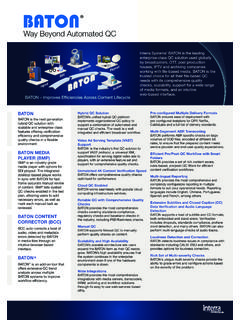Transcription of Identity and access management Beyond compliance
1 Identity and access management Beyond complianceInsights on governance, risk and complianceMay 2013iiiInsights on governance, risk and compliance | May 2013 Evolution of IAM moving Beyond compliance ..1 IAM life cycle phases ..2 IAM and IT trends ..4 Mobile computing ..4 Cloud computing ..5 Data loss prevention ..6 Social media ..6 Capability maturity model ..8 Transforming IAM ..10 Key considerations when transforming IAM ..12 IAM tools ..14 Getting started ..16 Conclusion ..18 Contents 1 Insights on governance, risk and compliance | May 2013 Evolution of IAM moving Beyond compliance Identity and access management (IAM) is the discipline for managing access to enterprise resources. It is a foundational element of any information security program and one of the security areas that users interact with the most.
2 In the past, IAM was focused on establishing capabilities to support access management and access -related compliance needs. The solutions were often focused on provisioning technology and were poorly adopted; they also resulted in high costs and realized limited value. Organizations often struggled to meet compliance demands during this period, and the solutions were deployed to manage very few applications and systems. Centralized, standardized, automated Identity management services designed to reduce risk, cost, improve operational efficiency continued to be elusive. Many organizations now understand, or meet, their compliance requirements. While compliance is still a key driver in IAM initiatives, IAM is evolving into a risk-based program with capabilities focused on entitlement management and enforcement of logical access controls.
3 Organizations are starting to achieve benefits from their IAM costs but are still challenged with managing time-intensive processes such as manual approval, provisioning and access review. Identity administration functions continue to be delivered in organizational silos resulting in users with excessive access , inefficient processes and higher cost of provisioning and de-provisioning. As IAM continues to evolve, organizations will look to broader, enterprise-based solutions that are adaptable to new usage trends such as mobile and cloud computing. IAM capabilities will continue to leverage technologies to realize higher benefits versus the costs incurred. User demand will continue to drive the discipline to transform from a compliance -based program into a true business enabler ( , IAM is a key component for rolling out B2E and B2C applications that will drive operational efficiencies and improve the user experience) while helping to reduce risks created by emerging technologies and threats.
4 To help reach the goal of an enabler that reduces risks, this IAM-focused paper explains life cycle phases, relevant IT trends, a capability maturity model, key considerations for transformation, tools and how to get the past Project-based deployment compliance -driven approach Provisioning focused Individual employee Identity management High cost vs. benefits realized Limited compliance value Limited view of enterprise access Poor application adoptionIAM the present Program-based deployment Risk-driven approach Entitlement management focused All user Identity management ( , employees, contractors, system accounts) High compliance value High compliance cost Moderate benefits realized vs. cost Central view of access Increased application adoptionIAM the future Enterprise-based deployment Capability-driven approach Business enablement driven High benefits realized vs.
5 Cost High business value Beyond compliance Central view of access by technology Strong technology adoptionEarly 2000s Well-publicized control failures Circa 2005 access control (SOX) and manual access review processes implementedToday access review fatigue; struggling to incorporate new technologies2 Insights on governance, risk and compliance | May 2013 The management of Identity and access permissions can be viewed as multiple stages. The IAM life cycle diagram illustrates the stages that users proceed through when joining a business workforce and obtaining access to the tools and assets necessary to do their job. The IAM life cycle also includes stages to ensure that employees maintain appropriate access as they move within the organization with access being revoked or changed when they separate or change roles.
6 An IAM program requires a well-defined strategy and governance model to guide all the life cycle phases. IAM life cycle phasesUser access request and approveDefinition objective: Gaining access to the applications, systems and data required to be challenges: Processes differ by location, business unit and resource. Approvers have insufficient context of user access needs do users really need access to private or confidential data. Users find it difficult to request required objective: Enforcing that access within the system, matching approved access challenges: Actual rights on systems exceed access levels that were originally approved/provisioned. There is no single authoritative Identity repository for and certifyDefinition objective: Reviewing user access periodically to realign it with job function or challenges: Processes are manual and differ by location, business unit and resource.
7 Reviewers must complete multiple, redundant and granular access reviews. Reviewers have insufficient context of user access should align the IAM program with both business objectives and the risk landscape. When solutions are focused on the business unit, they often fail to support the entire enterprise requirements and increase the cost of IAM. Typical pitfalls include the difficulty of managing access consistently across the enterprise and the increased complexity (which also drives up the cost) of incorporating new technologies into the existing IAM processes. Finally, it is essential to actively educate users about the policies behind IAM to support governance objectives, thus allowing IAM to quickly adapt to new on governance, risk and compliance | May 2013IT resourcesIdentityAccessUser access requestand approveProvision/de-provisionEnforceRepo rt andauditReview andcertifyReconcileStrategy and governanceReport and auditDefinition objective: Defining business-relevant key performance indicators (KPIs) and metrics.
8 Auditing user challenges KPIs/metrics do not exist or do not align with business-driven success criteria ( , reduce risk by removing terminated user access on the day of termination). Audits are labor objective: Enforcing user access to applications and systems using authentication and authorization. Enforcing compliance with access management policies and challenges: Applications do not support central access management solutions (directories, web single sign-on) . access management policies do not exist . Role/rule-based access is used inconsistently. Segregation of duties (toxic combinations) is not enforcedProvision/de-provisionDefinition objective: Granting users appropriate entitlements and access in a timely manner . Revoking access in a timely manner when no longer required due to termination or challenges Time lines to grant/remove access are excessive.
9 Inefficient and error-prone manual provisioning processes are used. access profile cloning occurs inappropriately. Ad hoc job role to access profile mappings exist. Inappropriate access may not be life cycle4 Insights on governance, risk and compliance | May 2013 IAM is a key element in enabling the use of these technologies and achieving business objectives, further emphasizing the need for IAM to grow Beyond a mere compliance solution into a valued business tool. Mobile computing As today s workforce becomes more mobile, many organizations are adopting a bring your own device (BYOD) approach to provide remote access to email, sensitive or privacy-related data, and business applications. Consumer demand for mobile computing is also driving organizations to develop mobile applications to be used by customers to access their products.
10 IAM is a strong enabler of mobile computing (both for business to employee and business to consumer) and serves as a foundational component in mobile computing security. Here are a few ways IAM can help an organization implement a more secure mobile computing program: Security safeguards normally in place for external connections to a network may be disabled or implemented at a reduced level because the business may not have control over management of these devices (especially in a BYOD model). As a result, it is critical that authentication mechanisms are implemented to confirm that the user of the device is authorized to access sensitive resources. Mobile devices allow company personnel to access critical applications (including privacy-related data) any time and from anywhere.















